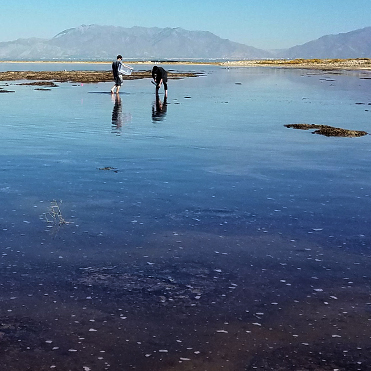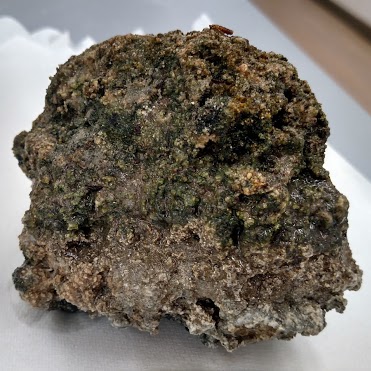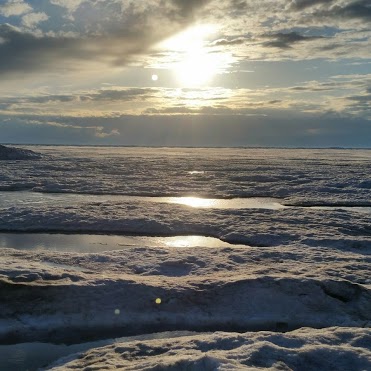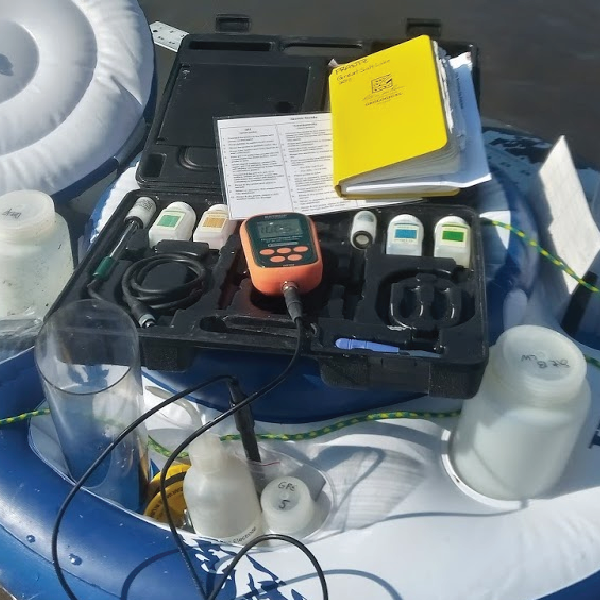
What are the environmental conditions that form carbonates?
We are using Great Salt Lake as a living geomicrobiology laboratory.
Research with Dr. Frantz combines field-based studies, sampling, chemical/geochemical analyses, laboratory-based experimental approaches, and computational modeling to understand the interactions between microorganisms and their environment, particularly in times of climate change. Dr. Frantz studies both modern environments and periods of extreme climate in the rock record.
There are frequently numerous opportunities for student involvement; click here to see a list of undergraduate research projects. Note: Dr. Frantz is not currently recruiting research students. Check back in future semesters for availability.
Current research students: access the Lab Research Page here (requires password).

What are the environmental conditions that form carbonates?
We are using Great Salt Lake as a living geomicrobiology laboratory.

How do microbes build rock?
What can stromatolites and other microbialites tell us about past environments and climate?

What's happening to sea ice in the Arctic?
How are microbes involved?

Students working with me have done projects ranging from bacteriophage isolation to models of local air quality.
I may not have the answers, but I'm happy to help you find them.
Open science repositories, useful widgets, and other stuff for furthering science outreach, education, and research.
 |
Github repository for research- and teaching-related code |
| Research Gate publications and abstracts | |
 |
Wikimedia Commons free use licensed illustrations for Earth science education |
 |
M. Ingalls, H. Leapaldt, K. Snell, C. Frantz, L. Trower, S. Widlansky, W. Clyde, J. Olsen-Valdez. 2023 Green Lake Geobiology MS raw data. Open Science Framework. doi:10.17605/OSF.IO/WHX94 |
 |
L. Wilcock, C. Frantz, M. Vanden Berg. Great Salt Lake microbialite map via remote imagery. Open Science Framework. doi:10.17605/OSF.IO/UF9YG |
 |
C. Frantz. Great Salt Lake Microbialite Observatory. Open Science Framework. View-only link |
 |
C. Frantz (2023) Great Salt Lake experimental & environmental DNA. BioProject PRJNA916983. NCBI GenBank. Accession PRJNA916983 |
 |
C. Frantz, C. Gibby, R. Nilson, M. Nguyen, C. Ellsworth, C. Stern, H. Dolan, A. Sihapanya, J. Aeschlimann, B. Baxter (2023) Great Salt Lake microbialite desiccation. Open Science Framework. View-only link |
 |
H. Leapaldt, C. Frantz (2022) Lake sediment DNA. BioProject PRJNA916981. NCBI GenBank. Accession PRJNA916981 |
 |
M. Ingalls, L. Trower, K. Snell, A. Fetrow, C. Frantz (2020) Giant stromatolites of the Green River Formation, LaClede Bed, Laney Member, Sand Wash Basin. Open Science Framework. doi:10.17605/OSF.IO/WB7UK |
 |
C. Frantz, M. Ingalls (2019) Great Salt Lake sediment metagenome raw sequence reads. BioProject PRJNA566403. NCBI GenBank. Accession PRJNA566403 |
 |
K. Junge (2017) Extreme summer melt: Assessing the habitability and physical structure of rotting first-year Arctic sea ice. Chukchi Sea, Alaska. 2015-2018. Arctic Data Center. doi:10.18739/A28C9R366. |
J. Jung, C. M. Frantz, D. P. Fernandez, M. S. Werner (2024). Toxic elements in benthic lacustrine sediments of Utah’s Great Salt Lake following a historic low in elevation. Frontiers in Soil Science, 4. doi:10.3389/fsoil.2024.1445792
H. C. Leapaldt, C. M. Frantz, J. Olsen-Valdez, K. E. Snell, E. J. Trower, M. Ingalls (2024) Primary to post-depositional microbial controls on the stable and clumped isotope record of shoreline sediments at Fayetteville Green Lake. Geobiology, 22:e12609. doi:10.1111/gbi.12609
L. Wilcock, C. Frantz, M. Vanden Berg. (2024) Use of remote imagery to map microbialite distribution at Great Salt Lake, Utah: Implications for microbialite exposure. Utah Geological Association Guides, 51:05. doi:10.31711/ugap.v51li.136
M. Vanden Berg, R. L. Ford, C. Frantz, H. Hurlow, K. Gunderson, G. Atwood (eds.) (2024). Great Salt Lake and the Bonneville Basin: Geologic History and Anthropocene Issues. Utah Geological Association Publication, v. 51. Salt Lake City, Utah. doi:10.31711/ugap.v51li
C. Frantz, C. Gibby, R. Nilson, C. J. Stern, M. Nguyen, C. Ellsworth, H. Dolan, A. Sihapanya, J. Aeschlimann, B. K. Baxter (2023). Desiccation of ecosystem-critical microbialites in the shrinking Great Salt Lake, Utah (USA). PLOS Water, 2:e0000100. doi:10.1371/journal.pwat.0000100
M. Ingalls, A. Fetrow, K. Snell, C. Frantz, E. Trower (2021). Lake level controls the recurrence of giant stromatolite facies. Sedimentology, 69:1649-1674. doi:10.1111/sed.12967
M. Ingalls, C. Frantz, K. Snell, E. Trower (2020). Carbonate facies-specific stable isotope data record climate, hydrology, and microbial communities in Great Salt Lake, UT. Geobiology, 18:566-593. doi:10.1111/gbi.12386
C. Frantz, B. Light, S. Farley, S. Carpenter, R. Lieplappen, Z. Courville, M. Orellana, & K. Junge (2019). Physical and optical characteristics of heavily melted "rotten" Arctic sea ice.The Cryosphere, 13:775-793. doi:10.5194/tc-2018-141
D. Newell, J. Jensen, C. Frantz, M. Vanden Berg (2017). Great Salt Lake (Utah) microbialite δ13C, δ18O, and δ15N record fluctuations in lake biogeochemistry since the Late Pleistocene. Geochemistry, Geophysics, Geosystems, 18:3631-3645. doi:10.1002/2017GC007078
 S. Domagal-Goldman, K. Wright, K. Adamala, L. de la Rubia, J. Bond, L. Dartnell, A. Goldman, K. Lynch, M.-E. Naud, I. Paulino-Lima, K. Singer, M. Walter-Antonio, X. Abrevaya, R. Anderson, G. Arney, D. Atri, A. Azua, J. Bowman, W. Brazelton, G. Brennecka, R. Carns, A. Chopra, J. Colangelo-Lillis, C. Crockett, J. DeMarines, E. Frank, C. Frantz, E. de la Fuente, D. Galante, J. Glass, D. Gleeson, C. Glein, C. Goldblatt, R. Horak, L. Horodyskyj, B. Kaçar, A. Kereszturi, E. Knowles, P. Mayeur, S. McGlynn, Y. Miguel, M. Montgomery, C. Neish, L. Noack, V. Petryshyn, S. Rugheimer, E. Stüeken, P. Tamez-Hidalgo, S. Walker, T. Wong (2016). The Astrobiology Primer 2.0. Astrobiology, 16:561-653. doi:10.1089/ast.2015.1460
S. Domagal-Goldman, K. Wright, K. Adamala, L. de la Rubia, J. Bond, L. Dartnell, A. Goldman, K. Lynch, M.-E. Naud, I. Paulino-Lima, K. Singer, M. Walter-Antonio, X. Abrevaya, R. Anderson, G. Arney, D. Atri, A. Azua, J. Bowman, W. Brazelton, G. Brennecka, R. Carns, A. Chopra, J. Colangelo-Lillis, C. Crockett, J. DeMarines, E. Frank, C. Frantz, E. de la Fuente, D. Galante, J. Glass, D. Gleeson, C. Glein, C. Goldblatt, R. Horak, L. Horodyskyj, B. Kaçar, A. Kereszturi, E. Knowles, P. Mayeur, S. McGlynn, Y. Miguel, M. Montgomery, C. Neish, L. Noack, V. Petryshyn, S. Rugheimer, E. Stüeken, P. Tamez-Hidalgo, S. Walker, T. Wong (2016). The Astrobiology Primer 2.0. Astrobiology, 16:561-653. doi:10.1089/ast.2015.1460
V. Petryshyn, M. Juarez Rivera, H. Agic, C. Frantz, F. Corsetti, A. Tripati (2016). Stromatolites in Walker Lake (Nevada, Great Basin, USA) record climate and lake level changes ~35,000 years ago. Palaeogeography, Palaeoclimatology, Palaeoecology, 451:140-151. doi:10.1016/j.palaeo.2016.02.054
V. Petryshyn, F. Corsetti, C. Frantz, S. Lund, W. Berelson (2016). Magnetic susceptibility as a biosignature in stromatolites. Earth and Planetary Science Letters, 437:66-75. doi:10.1016/j.epsl.2015.12.016
C. Frantz, V. Petryshyn, F. Corsetti (2015). Grain trapping and binding by filamentous cyanobacterial and algal mats: Implications for stromatolite microfabrics through time. Geobiology, 13:409-423. doi:10.1111/gbi.12145 Issue cover →
C. Frantz, V. Petryshyn, P. Marenco, W. Berelson, A. Tripati, F. Corsetti (2014). Dramatic local environmental change during the Early Eocene Climatic Optimum detected using chemical analyses of a Green River Formation stromatolite. Palaeogeography, Palaeoclimatology, Palaeoecology, 405:1-15. doi:10.1016/j.palaeo.2014.04.001